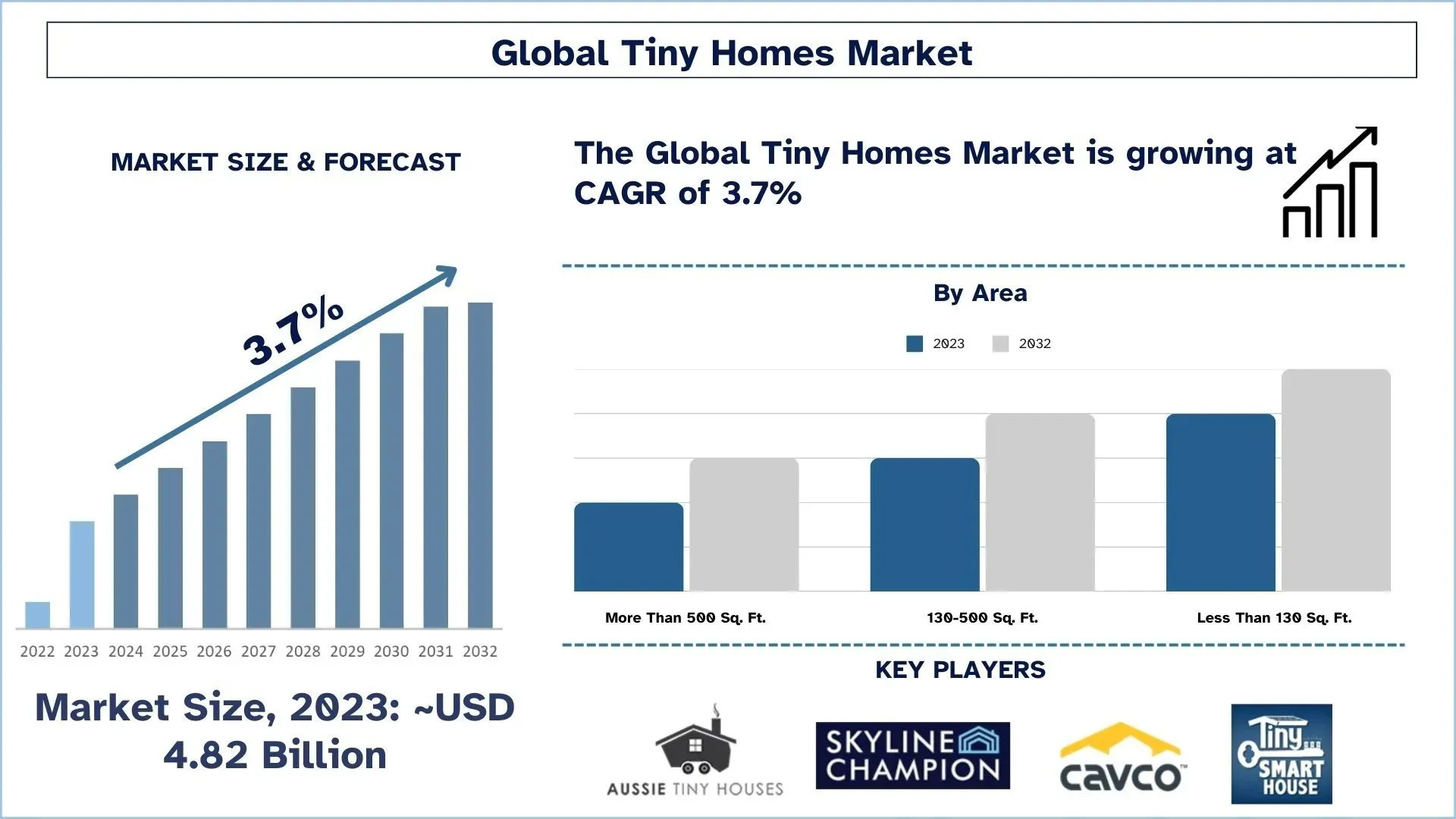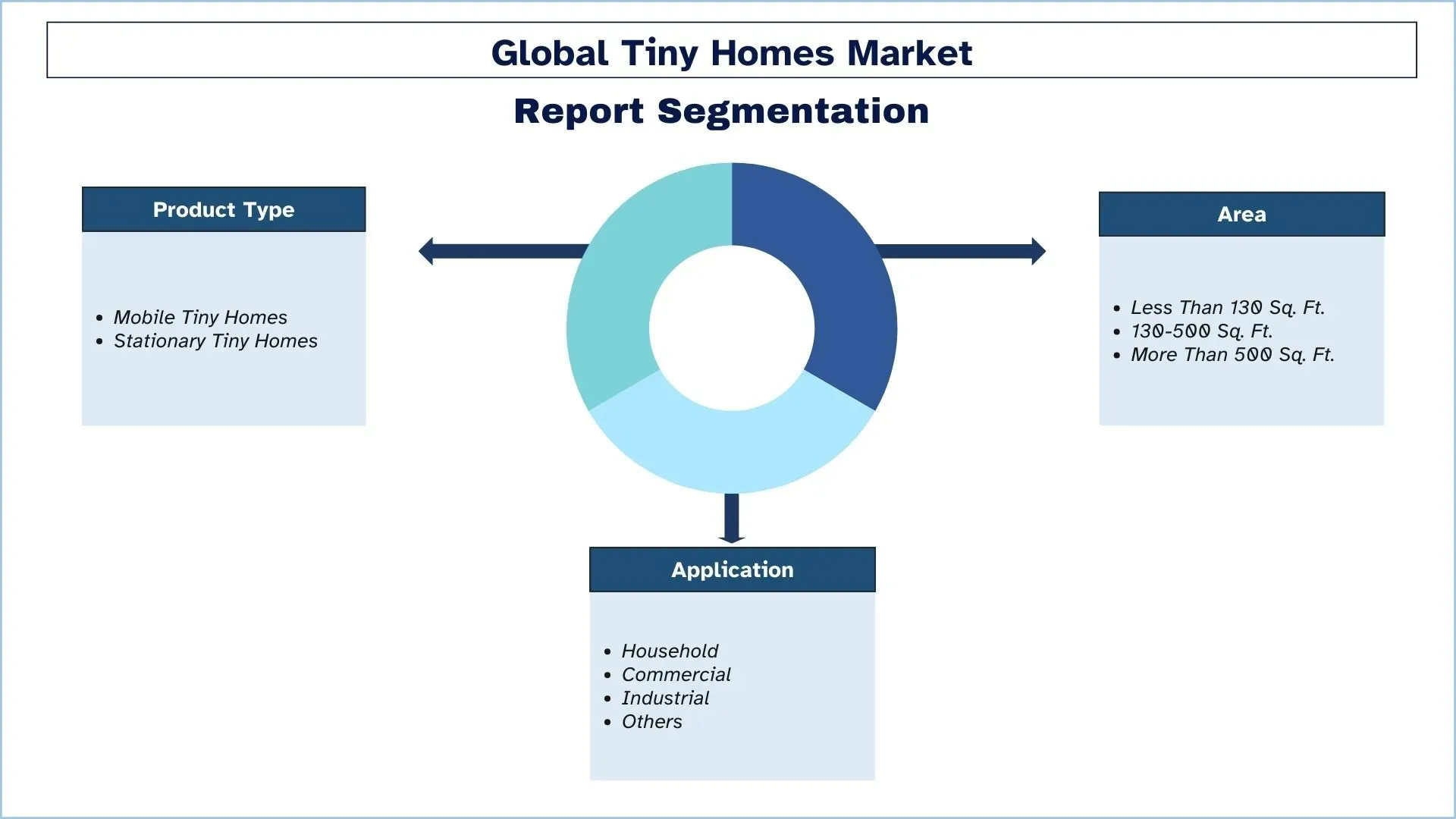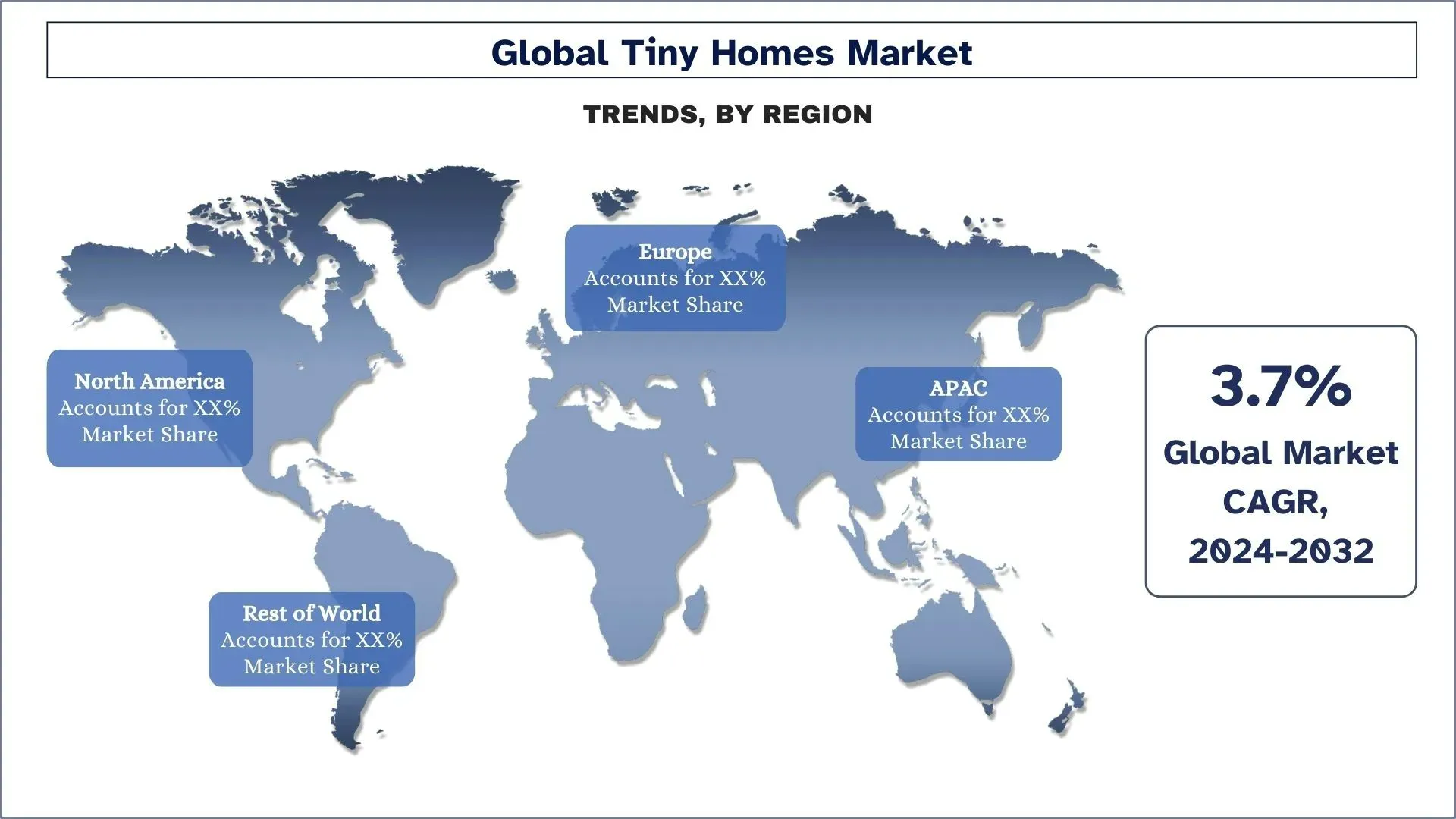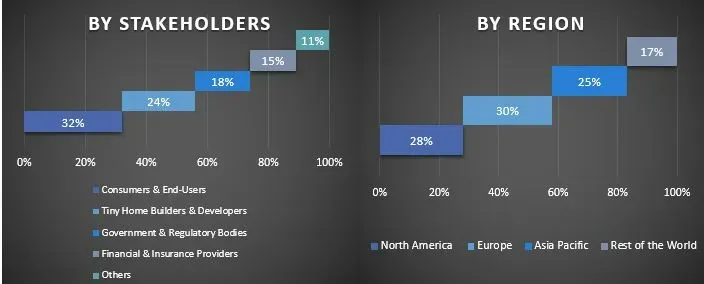- Home
- About Us
- Industry
- Services
- Reading
- Contact Us
Tiny Homes Market: Current Analysis and Forecast (2024-2032)
Emphasis on Product Type (Mobile Tiny Homes and Stationary Tiny Homes); Area (Less Than 130 Sq. Ft., 130-500 Sq. Ft., and More Than 500 Sq. Ft.); Application (Household, Commercial, Industrial, Others); and Region/Country

Global Tiny Homes Market Size & Forecast
The global Tiny Homes Market was valued at USD 4.82 Billion in 2023 and is expected to grow at a strong CAGR of around 3.7% during the forecast period (2024-2032) owing to increasing real estate prices making tiny homes an affordable alternative for homeownership, attracting budget-conscious buyers and those seeking financial freedom.
Tiny Homes Market Analysis
The worldwide marketplace for compact houses experiences robust expansion due to its affordability, together with sustainability aspects and growing need for alternative living spaces. One of the main characteristics of a tiny house is its small size between 100 to 400 square feet, which creates efficiency in space usage while lowering environmental impact and residential costs. Four primary drivers of market growth include rising residential properties, urban population growth, population resizing tendencies, and support programs for different housing structures from the government. Market expansion occurs worldwide because of the off-grid life and green living trends that keep increasing in demand.
Global Tiny Homes Market Trends
This section discusses the key market trends that are influencing the various segments of the global Tiny Homes market, as found by our team of research experts.
Household Segment Transforming Industry
The household category is the largest contributor to the tiny homes industry because people are looking for budget-friendly, environmentally sound residential options. Rising property expenses coupled with changing life choices have led households to purchase tiny homes as primary houses, vacation retreats and secondary dwellings, thus increasing market acceptance for efficient space design.

North America is expected to grow at a considerable rate during the forecast period.
The North American tiny homes market demonstrates substantial growth because prices of housing continue to rise, and people seek affordable accommodation while embracing sustainable minimalistic living approaches. The market leadership comes from America and Canada because rules about tiny homes continue to expand to include usage as residences, vacation properties, and ADUs (Accessory Dwelling Units). Market demand accelerates because of government policies that support zoning flexibility across certain states, together with the increasing interest in mobile lifestyles and off-grid dwelling. The market growth of tiny homes receives additional support from technological advances that combine smart home features with eco-friendly materials which expand their target audience.

Global Tiny Homes Industry Competitive Landscape
The global Tiny Homes market is competitive, with several global and international market players. The key players are adopting different growth strategies to enhance their market presence, such as partnerships, agreements, collaborations, new product launches, geographical expansions, and mergers and acquisitions.
Top Tiny Homes Manufacturing Companies
Some of the major players in the market are Skyline Homes; CargoHome; Tiny SMART House, Inc.; Tumbleweed Tiny House Company; Clayton (Berkshire Hathaway Inc.); Aussie Tiny Houses; Mustard Seed Tiny Homes LLC; MINI MANSIONS TINY HOME BUILDERS; Cavco Industries, Inc.; Nestron
Global Tiny Homes Market Report Coverage
Report Attribute | Details |
Base year | 2023 |
Forecast period | 2024-2032 |
Growth momentum | Accelerate at a CAGR of 3.7% |
Market size 2023 | USD 4.82 Billion |
Regional analysis | North America, Europe, APAC, Rest of the World |
Major contributing region | North America is expected to dominate the market during the forecast period. |
Key countries covered | U.S., Canada, Germany, U.K., Spain, Italy, France, China, Japan, and India |
Companies profiled | Skyline Homes; CargoHome; Tiny SMART House, Inc.; Tumbleweed Tiny House Company; Clayton (Berkshire Hathaway Inc.); Aussie Tiny Houses; Mustard Seed Tiny Homes LLC; MINI MANSIONS TINY HOME BUILDERS; Cavco Industries, Inc.; Nestron |
Report Scope | Market Trends, Drivers, and Restraints; Revenue Estimation and Forecast; Segmentation Analysis; Demand and Supply Side Analysis; Competitive Landscape; Company Profiling |
Segments Covered | By Product Type; By Area; By Application; By Region/Country |
Reasons to buy this report:
The study includes market sizing and forecasting analysis confirmed by authenticated key industry experts.
The report briefly reviews overall industry performance at one glance.
The report covers an in-depth analysis of prominent industry peers, primarily focusing on key business financials, type portfolios, expansion strategies, and recent developments.
Detailed examination of drivers, restraints, key trends, and opportunities prevailing in the industry.
The study comprehensively covers the market across different segments.
Deep dive regional level analysis of the industry.
Customization Options:
The global tiny homes market can further be customized as per the requirement or any other market segment. Besides this, UMI understands that you may have your own business needs, hence feel free to contact us to get a report that completely suits your requirements.
Table of Content
Research Methodology for the Global Tiny Homes Market Analysis (2024-2032)
Analyzing the historical market, estimating the current market, and forecasting the future market of the global Tiny Homes market were the three major steps undertaken to create and analyze the adoption of global Tiny Homes in major regions. Exhaustive secondary research was conducted to collect the historical market figures and estimate the current market size. Secondly, to confirm these insights, numerous findings and assumptions were considered. Moreover, exhaustive primary interviews were conducted with industry experts across the value chain of the global Tiny Homes market. For the assumption and validation of market numbers through primary interviews, we employed a top-down/bottom-up approach to forecasting the complete market size. Thereafter, market breakdown and data triangulation methods were adopted to estimate and analyze the market size of segments and sub-segments of the industry. The detailed methodology is explained below:
Analysis of Historical Market Size
Step 1: In-Depth Study of Secondary Sources:
A detailed secondary study was conducted to obtain the historical market size of the global Tiny Homes market through company internal sources such as annual reports & financial statements, performance presentations, press releases, etc., and external sources including journals & articles, government publications, competitor reports, third-party databases, and other credible publications.
Step 2: Market Segmentation:
After obtaining the historical market size of the global Tiny Homes market, we conducted a detailed secondary analysis to gather historical market insights and share for different segments & sub-segments for major regions. Major segments, such as product type, area, application, and region, are included in the report. Further country-level analysis was conducted to evaluate the overall adoption of testing models in that region.
Step 3: Factor Analysis:
After acquiring the historical market size of different segments and sub-segments, we conducted a detailed factor analysis to estimate the current market size of the global Tiny Homes market. Further, we conducted factor analysis using dependent and independent variables such as product type, area, application, and global Tiny Homes market regions. A thorough analysis of demand and supply-side scenarios was conducted considering top partnerships, mergers and acquisitions, business expansion, and product launches in the global Tiny Homes market.
Current Market Size Estimate & Forecast
Current Market Sizing: Based on actionable insights from the above 3 steps, we arrived at the current market size, key players in the global Tiny Homes market, and market shares of the segments. All the required percentage shares split and market breakdowns were decided using the above-mentioned secondary approach and were verified through primary interviews.
Estimation & Forecasting: For market estimation and forecast, weights were assigned to several factors including drivers & trends, restraints, and opportunities available for the stakeholders. After analyzing these factors, relevant forecasting techniques, i.e., the top-down/bottom-up approach were applied to arrive at the market forecast for 2032 for different segments and sub-segments across the major markets globally. The research method adopted to estimate the market size encompasses:
The industry’s market size, in terms of revenue (USD) and the adoption rate of the global Tiny Homes market across the major markets domestically
All percentage shares, splits, and breakdowns of market segments and sub-segments
Key players in the global Tiny Homes market in terms of the types offered. Also, the growth strategies adopted by these players to compete in the fast-growing market.
Market Size and Share Validation
Primary Research: In-depth interviews were conducted with the Key Opinion Leaders (KOLs) including Top Level Executives (CXO/VPs, Sales Head, Marketing Head, Operational Head, Regional Head, Country Head, etc.) across major regions. Primary research findings were then summarized, and statistical analysis was performed to prove the stated hypothesis. Inputs from primary research were combined with secondary findings, hence turning information into actionable insights.
Split of Primary Participants in Different Regions

Market Engineering
The data triangulation technique was employed to complete the overall market estimation and to arrive at precise statistical numbers for each segment and sub-segment of the global Tiny Homes market. After studying various parameters and trends in the global Tiny Homes market's product type, area, application, and regions, data was split into several segments and sub-segments.
The Main Objective of the Global Tiny Homes Market Study
The current & future market trends of the global Tiny Homes market were pinpointed in the study. Investors can gain strategic insights to base their discretion for investments on the qualitative and quantitative analysis performed in the study. Current and future market trends determined the market's overall attractiveness at a regional level, providing a platform for the industrial participant to exploit the untapped market to receive help from a first-mover advantage. Other quantitative goals of the studies include:
Analyze the current forecast and market size of the global Tiny Homes market in terms of value (USD). Also, analyze the current forecast and market size of different segments and sub-segments.
Segments in the study include areas of product type, area, application, and regions.
Define and analyze the regulatory framework for the industry.
Analyze the value chain involved with the presence of various intermediaries, along with analyzing customer and competitor behaviors of the industry.
Analyze the current and forecast market size of the global Tiny Homes market for the major regions.
Major countries of regions studied in the report include Asia Pacific, Europe, North America, and the Rest of the World.
Company profiles of the global Tiny Homes market and the growth strategies the players adopt to sustain the fast-growing market.
Deep dive regional level analysis of the industry.
Frequently Asked Questions FAQs
Q1: What is the global Tiny Homes market’s current market size and growth potential?
The global tiny homes market was valued at USD 4.82 Billion in 2023 and is expected to grow at a CAGR of 3.7% during the forecast period (2024-2032).
Q2: What are the driving factors for the growth of the global Tiny Homes market?
Integration of IoT, automation, and smart appliances enhances efficiency, convenience, and energy management in tiny homes.
Q3: Which segment has the largest global Tiny Homes market share by application category?
The household category has the largest share of the global tiny homes market by application segment.
Q4: What are the emerging technologies and trends in the global tiny homes market?
Sustainable construction materials like bamboo, recycled wood, and hempcrete are gaining traction in tiny home manufacturing.
Q5: Which regions dominate the global Tiny Homes market?
North America is expected to dominate the market during the forecast period.
Related Reports
Customers who bought this item also bought










